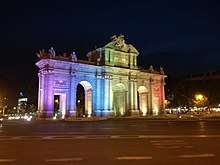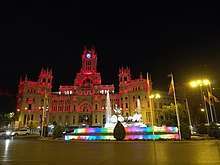Madrid Pride
Madrid Pride, popularly known in Spanish as the Orgullo Gay de Madrid and its acronym MADO,[1] is the annual LGBT pride festival hosted at Chueca neighborhood in the center of Madrid, during the weekend immediately after June 28, International Day of LGBT Pride.[2]
The celebration usually begins Wednesday afternoon with the popular announcement at Chueca Square, carried out by notorious public figures, and ends on Sunday, after the parade of claiming floats that takes place on Saturday.
Madrid Pride has gone from being a small concentration of people in the late 70's and early 80's to being considered the biggest gay party in Europe and one of the most important in the world, only surpassed by the city of San Francisco (California), attracting more than a million and a half people each year (300,000 of them foreign tourists) and with an estimated contribution to the economy of the city over €150 million in 2015, consecrating itself as one of the most important and multitudinous festivals in all of Spain.[3]
_16.jpg)
.jpg)
In July 2017 Madrid hosted WorldPride Madrid 2017, the 5th Edition of the biggest LGBT event in the world.
History
After the incidents of June 28, 1970 in the New York pub Stonewall Inn, many cities in the world began to celebrate mass demonstrations in repulsion, but in Spain the dictatorial Franco regime of the time avoided the news entry in the country. Thus, it was not until 1977, two years after the death of the dictator, that in Barcelona was celebrated for the first time in Spain a demonstration in favor of the rights of homosexual people. It hardly concentrated 4,000 people who were dissolved by force. The following year, in 1978, the demonstration was authorized in Madrid and since then, except in 1980, Madrid Pride is celebrated annually. By those first years, the demonstration started at Santo Domingo square and finished at Puerta del Sol square.
In 1986, a seminar on homosexuality was organized in Chueca neighbourhood, which was the seed to constitute the Lesbian, Gay, Transsexual and Bisexual Group of Madrid (COGAM, from Colectivo de Lesbianas, Gays, Transexuales y Bisexuales de Madrid). At that time it was becoming common that after the demonstration the participants returned to Chueca to celebrate and the protest started taking on a festive character. Years later, in 1996, the magazine Shangay introduced in the parade the first carriage, with Alaska cheering the parade. Since then, the number of people has been increasing each year.
In 2005, with the approval of equal marriage in Spain, there was an explosion of assistance to Madrid Pride, which for the first time reached up to two million people. This made Madrid to be chosen as the European capital of Pride, celebrating Europride 2007, which was attended by more than 2.5 million people from around the world.
In October 2012, InterPride members voted in favor of holding the 5th WorldPride 2017 Edition to the city of Madrid, surpassing Berlin and Sydney.
Nowadays, nearly 2 million people are out on the streets during the Pride Week, thus becoming one of the most crowded parties, not only in the capital, but also in the whole Spain, and being the European city with the largest number of attendees to the march of Pride, far above cities like London or Paris and only behind the San Francisco Pride.[4]
In 2016, the number of concerts and security of the event was increased in order to start preparing for 2017, in which Madrid will celebrate the largest LGBT event in the world, the WorldPride, being expected a record attendance of 3 million people. Large concerts were installed in larger spaces such as Puerta del Sol, Plaza de España and Puerta de Alcalá. The City Council declared the Madrid Pride Celebrations as a Festival of General Interest in July 2016.[5]
WorldPride Madrid 2017
In October 2012, InterPride's membership voted at its annual conference in Boston, Massachusetts, United States, to award WorldPride 2017[6] to the city of Madrid, Spain.[7] The other candidate cities to host the event in 2017 were Berlin and Sydney, but Madrid won unanimously[8] in the voting of more than 80 delegations from around the world.

_during_WorldPride_2017.jpg)

This celebration in Madrid coincided in time with the 24th Europride, which was hosted for the second time in the Spanish capital (the first one was in 2007). It took place from June 23 to 2 July 2017.[9] The event's slogan was "Whoever you love, Madrid loves you!",[10] and the song chosen as the anthem was ¿A quién le importa? by Alaska y Dinarama, which was specially adapted for the event with the collaboration of several Spanish popular singers among the LGBT community, including Fangoria (band) -the group of two of the three former members of Alaska y Dinarama-.[11]
WorldPride Madrid 2017 also coincided with two key anniversaries in the history of the LGBT community in Madrid and Spain: the 40th anniversary of the first demonstration in Spain in support of the rights of homosexual people -which took place in Barcelona in 1977- and the 25th anniversary of the foundation of the State Federation of Lesbians, Gays, Transsexuals and Bisexuals (FELGTB, from Federación Estatal de Lesbianas, Gays, Transexuales y Bisexuales).
The opening ceremony of the event took place at the Calderón Theatre on Friday, June 23, 2017. Few days later, on Monday, June 26, the Madrid Summit, the International Conference on Human Rights, was inaugurated at the Autonomous University. Several cultural events took place in the subsequent days, including the traditional and massive demonstration on July 1, with up to 52 carriages going all over the 2 kilometers between Atocha (Plaza del Emperador Carlos V) and Plaza de Colón. The WorldPride closing ceremony took place on July 2, giving the baton to New York City for the celebration of WorldPride 2019.
References
- ↑ La Vanguardia, ed. (June 25, 2016). "Eurovisión, muy presente en las fiestas de 'Mado 2016'" (in Spanish). Retrieved 2017-05-12.
- ↑ Mario Navarro Egea. Agenda de Ocio, ed. "Madrid se prepara para el Orgullo Gay, el mayor evento de la ciudad" (in Spanish). Retrieved 2017-05-12.
- ↑ "Orgullo Madrid" (in Spanish). July 5, 2015. Retrieved 2017-05-12.
- ↑ "La historia sin vergüenza del Orgullo" (in Spanish). June 20, 2011. Retrieved 2017-05-13.
- ↑ "Orgullo de 2016" (in Spanish). June 6, 2016. Retrieved 2017-05-13.
- ↑ "WorldPride Madrid 2017". Madrid Pride. 2016-11-21.
- ↑ Littauer, Dan (2012-10-08). "Madrid to host 2017 World Gay Pride". Gaystarnews.com. Retrieved 2013-03-05.
- ↑ "Madrid, elegida como sede de la WorldPride 2017". Europapress.es (news agency in Spanish). 2012-10-08. Retrieved 2017-05-11.
- ↑ "World Pride Madrid 2017". Official website of World Pride Madrid 2017. Retrieved 2017-05-11.
- ↑ "'Whoever you love, Madrid loves you', lema y presentación en Nueva York del World Pride". Official website of the Community of Madrid regional government (in Spanish). Retrieved 2017-06-29.
- ↑ "'A quién le importa': así suena el himno oficial del World Pride Madrid 2017". laSexta.com (Spanish TV channel) (in Spanish). 2017-06-29. Retrieved 2017-07-01.
